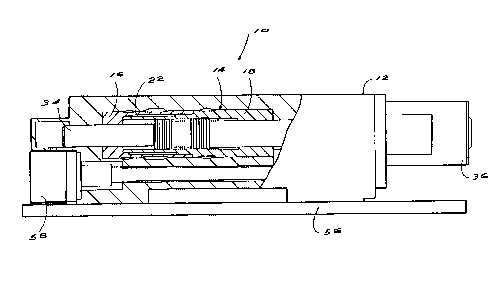Some of the information on this Web page has been provided by external sources. The Government of Canada is not responsible for the accuracy, reliability or currency of the information supplied by external sources. Users wishing to rely upon this information should consult directly with the source of the information. Content provided by external sources is not subject to official languages, privacy and accessibility requirements.
Any discrepancies in the text and image of the Claims and Abstract are due to differing posting times. Text of the Claims and Abstract are posted:
| (12) Patent: | (11) CA 2161129 |
|---|---|
| (54) English Title: | ROCK DRILL PERCUSSION MECHANISM |
| (54) French Title: | MECANISME POUR OUTIL DE FORAGE A PERCUSSION |
| Status: | Expired and beyond the Period of Reversal |
| (51) International Patent Classification (IPC): |
|
|---|---|
| (72) Inventors : |
|
| (73) Owners : |
|
| (71) Applicants : | |
| (74) Agent: | OYEN WIGGS GREEN & MUTALA LLP |
| (74) Associate agent: | |
| (45) Issued: | 2000-02-01 |
| (86) PCT Filing Date: | 1994-04-20 |
| (87) Open to Public Inspection: | 1994-10-27 |
| Examination requested: | 1997-04-14 |
| Availability of licence: | N/A |
| Dedicated to the Public: | N/A |
| (25) Language of filing: | English |
| Patent Cooperation Treaty (PCT): | Yes |
|---|---|
| (86) PCT Filing Number: | PCT/GB1994/000837 |
| (87) International Publication Number: | WO 1994023906 |
| (85) National Entry: | 1995-10-20 |
| (30) Application Priority Data: | |||||||||
|---|---|---|---|---|---|---|---|---|---|
|
A rock drill with a percussion mechanism which includes a piston (32), a body
(12) in
which is formed a chamber (14), at least a first cylinder (18) which is
located in the
chamber and which, on an inner side, forms at least part of a sleeve for the
piston (32),
and a valve (22), for controlling movement of the piston, which is located on
an outer
side of the first cylinder (18). Stop means (142) integrally attached to the
first cylinder
prevents the valve from being removed.
Un dispositif de perforation de roche pourvu d'un mécanisme de percussion comprenant un piston (32), un corps (12) dans lequel est formé une chambre (14), au moins un premier cylindre (18) qui est situé dans la chambre et qui, sur une face interne, forme au moins une partie du manchon du piston (32), et une soupape (22), régulant le déplacement du piston, qui est placée sur une face externe du premier cylindre (18). Un dispositif d'arrêt (142) solidaire du premier cylindre empêche le retrait de la soupape.
Note: Claims are shown in the official language in which they were submitted.
Note: Descriptions are shown in the official language in which they were submitted.

2024-08-01:As part of the Next Generation Patents (NGP) transition, the Canadian Patents Database (CPD) now contains a more detailed Event History, which replicates the Event Log of our new back-office solution.
Please note that "Inactive:" events refers to events no longer in use in our new back-office solution.
For a clearer understanding of the status of the application/patent presented on this page, the site Disclaimer , as well as the definitions for Patent , Event History , Maintenance Fee and Payment History should be consulted.
| Description | Date |
|---|---|
| Inactive: IPC from MCD | 2006-03-12 |
| Inactive: IPC from MCD | 2006-03-12 |
| Time Limit for Reversal Expired | 2003-04-22 |
| Letter Sent | 2002-04-22 |
| Grant by Issuance | 2000-02-01 |
| Inactive: Cover page published | 2000-01-31 |
| Inactive: Received pages at allowance | 1999-11-05 |
| Pre-grant | 1999-11-05 |
| Inactive: Final fee received | 1999-11-05 |
| Notice of Allowance is Issued | 1999-07-08 |
| Notice of Allowance is Issued | 1999-07-08 |
| Letter Sent | 1999-07-08 |
| Inactive: Approved for allowance (AFA) | 1999-06-04 |
| Letter Sent | 1999-05-27 |
| Reinstatement Requirements Deemed Compliant for All Abandonment Reasons | 1999-05-10 |
| Deemed Abandoned - Failure to Respond to Maintenance Fee Notice | 1999-04-20 |
| Amendment Received - Voluntary Amendment | 1999-03-05 |
| Inactive: S.30(2) Rules - Examiner requisition | 1998-12-16 |
| Inactive: Status info is complete as of Log entry date | 1997-07-29 |
| Inactive: Application prosecuted on TS as of Log entry date | 1997-07-29 |
| Request for Examination Requirements Determined Compliant | 1997-04-14 |
| All Requirements for Examination Determined Compliant | 1997-04-14 |
| Application Published (Open to Public Inspection) | 1994-10-27 |
| Abandonment Date | Reason | Reinstatement Date |
|---|---|---|
| 1999-04-20 |
The last payment was received on 1999-05-10
Note : If the full payment has not been received on or before the date indicated, a further fee may be required which may be one of the following
Please refer to the CIPO Patent Fees web page to see all current fee amounts.
| Fee Type | Anniversary Year | Due Date | Paid Date |
|---|---|---|---|
| Request for examination - standard | 1997-04-14 | ||
| MF (application, 4th anniv.) - standard | 04 | 1998-04-20 | 1998-04-14 |
| Reinstatement | 1999-05-10 | ||
| MF (application, 5th anniv.) - standard | 05 | 1999-04-20 | 1999-05-10 |
| Final fee - standard | 1999-11-05 | ||
| MF (patent, 6th anniv.) - standard | 2000-04-20 | 2000-04-19 | |
| MF (patent, 7th anniv.) - standard | 2001-04-20 | 2001-04-06 |
Note: Records showing the ownership history in alphabetical order.
| Current Owners on Record |
|---|
| JARMO UOLEVI LEPPANEN |
| ROGER ROBARTS BRIGGS |
| Past Owners on Record |
|---|
| None |